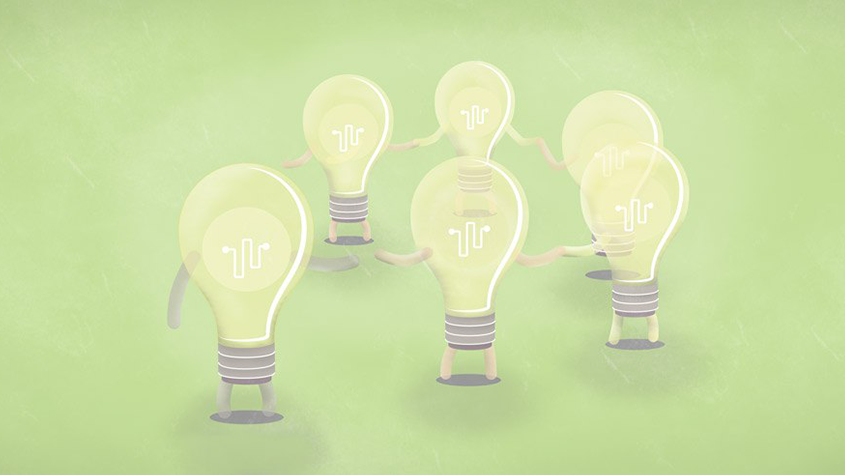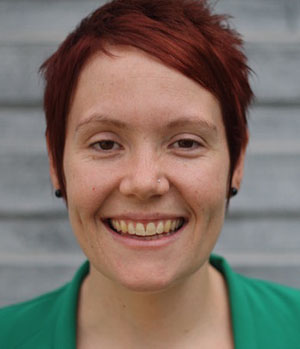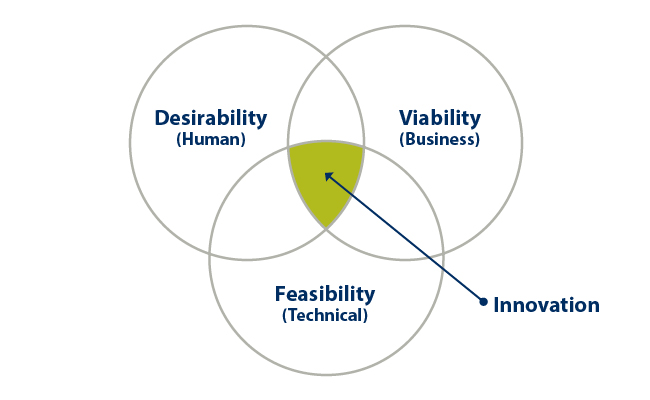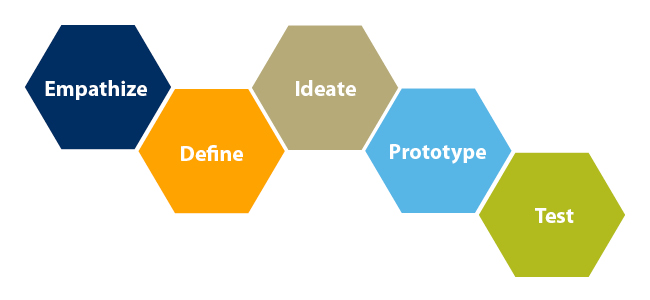
Kickstarting an innovation strategy
Four organisations in the disability sector share how and why they responded to sector changes by launching an innovation strategy.

- Four organisations in the disability sector – House With No Steps, Cerebral Palsy Alliance, Northcott and Life Without Barriers – describe their journeys to introduce and leverage innovation strategies.
- Driven by market changes brought about by NDIS, the four organisations are adopting formal innovation strategies that put the customer at the centre.
- Find out the structures that each organisation has adopted and the various ways they generate and source good ideas to achieve greater social impact.
Three months into the full implementation of the biggest reform the disability sector in Australia has ever seen, we spoke to four disability providers about their journey to introduce and leverage innovation strategies within their organisations. Having observed House with No Steps, Cerebral Palsy Alliance, Northcott and Life Without Barriers introduce innovation strategies over the past five years, we wanted to find out what was driving it and how it was being done.
The article explores:
- Why innovate?
- Anticipation of NDIS as the key driver
- Four key insights for implementing an innovation strategy including various structures and ways to generate ideas
- Case studies of each organisation’s approach.
We hope this article will assist others in the social purpose sector considering a similar journey.
Why innovate?
So, what do we mean by innovation? The Oxford Dictionary defines it as ‘A new method, idea, product, etc’.1
… innovation doesn’t need to be large, disruptive or product focused…
Lyn Ainsworth, Head of Strategy, Excellence & Innovation at House with No Steps, describes it as “turning ideas into action to create value”. Liz Forsyth, Executive Director at Northcott Innovation, describes it as “looking at a problem from many different angles, opening possibilities to solutions”.
All the interviewees stressed that innovation doesn’t need to be large, disruptive or product focused, and that smaller innovations are happening all the time that improve the way things are done.
A.G. Lafley and Ram Charan also make this point in the Fast Company article, Why Innovation Matters, ‘When innovation is at the center of a company’s way of doing things, it finds ways to innovate not just in products, but also in function, logistics, business models and process’.2
Organisations innovate to enter new markets, differentiate themselves, be competitive and remain relevant to customers. In the ‘corporate world’ innovation is a common business strategy (75% of US private companies are making innovation a priority).3

Ainsworth says that over the past five years there has been increasing recognition that disability service providers are working in a competitive environment. This is starting to drive a change in behaviour. In particular, disability organisations are asking, ‘how do we differentiate ourselves and how do we get customers to choose us?’

The four organisations we spoke to are no strangers to the concept of innovation. All are sizeable, well-funded organisations now, however several have humble beginnings as boot-strapped charities with ambitious missions and limited resources.
As Robyn Cummins, Innovation Manager at Cerebral Palsy Alliance puts it “we have always had to be innovative”. As with many charities, they had no choice in the early days to grow their impact with limited resources, meaning innovation is part of who they are.
Ainsworth refers to the proverb ‘necessity is the mother of invention’ when explaining this point, and says it is still very relevant for charities today. The shift for these four organisations is not the introduction of innovation, but rather the introduction of a formal, strategic approach to innovation
Anticipation of NDIS is the key driver
The key driver behind this increase in innovation is the National Disability Insurance Scheme (NDIS). The NDIS is bringing about huge change, that will result in a complete market restructure for disability service providers. Providers are having to rethink the way they do things, especially as the market becomes more competitive. This is an environment ripe for innovation. As a result, innovation is being introduced as a strategy to respond to changes across the sector.
By linking funding to results instead of activities, the door is opened to more innovative approaches to achieve outcomes.
For example, Geoff Aigner, Director of Social Innovation at Life Without Barriers, is investigating ways to use innovation to support the organisation’s compelling proposition, “to make people want to choose us”.
Both Aigner and Cummins spoke about their organisations transforming or transitioning from the old world of government block funding to the new world of NDIS. They said that innovation has an important role to play in this change. All the interviewees also spoke about the need to remain relevant to customers as competition increases and new market entrants arrive, and that an innovation strategy could help achieve this.
NDIS is also driving an outcomes-focused approach in the disability sector, a change that is happening across the social sector. By linking funding to results instead of activities, the door is opened to more innovative approaches to achieve outcomes.
Forsyth said that Northcott is seeing “the NDIS as an opportunity to develop new products and services that customers need, away from the constraints of government contracts”.

Supporting this trend, social purpose organisations are increasingly attracting talent from the for-profit world. These people are bringing new perspectives and management strategies, including knowledge of how to build and leverage innovation.
Four key insights for approaching innovation in your organisation
Our objective when speaking to the interviewees was to understand how innovation became a key strategy for their organisations, and how they are implementing the strategy.
Four key insights emerged that are relevant across the social purpose sector:
- Board engagement is key to adopting innovation strategies
- The initial investment need not be huge
- There are multiple structures you can adopt as part of your innovation strategy
- There are several ways to generate and source good ideas for your innovation strategy
1. Board engagement is key to adopting innovation strategies
The boards of the four organisations showed great openness to the idea of investing in innovation. Anticipation of the NDIS helped to get innovation on the agenda. Boards understood the need to respond to this huge sector shift and this contributed to them being more receptive.
The board sees innovation as a significant strategy for managing long-term strategic risk.
Forsyth said “the Chairman and CEO had been focused on innovation for a long time and saw it as part of adopting a business strategy”.
Similarly, Ainsworth said “the board sees innovation as a significant strategy for managing long-term strategic risk. This aligned with the approach increasingly being taken by international corporations.”

In addition, each board had representatives from commercial backgrounds who championed the idea of increased innovation. The market restructure being driven by the NDIS helped boards make the logical link between commerciality and the need for innovation. Cummins noted “the majority of our Board have a commercial background and knew what it would take to transform”.
2. The initial investment need not be huge
The four organisations all demonstrated that adopting an innovation strategy does not require a large upfront investment. A lean approach is well known to many social purpose organisations and can be used for innovation as well.
… [internal] volunteers… help expedite the discovery and implementation processes in a lean way.
For example, Northcott provides seed funding to Northcott Innovation to cover staff resources (two people) and to seed fund projects and innovation pilots. When Cerebral Palsy Alliance first embarked on its innovation journey the budget covered one salary and innovations were considered on the merits of the business case. Now innovation is so embedded in the organisation, its budget is absorbed into the business plan. Life Without Barriers is leveraging internal volunteers to add value to its innovation strategy. These volunteers bring valuable knowledge about customers and operations to the innovation agenda and help expedite the discovery and implementation processes in a lean way.
For these organisations, larger investment might only be required later in the journey to take a particular innovation to scale. This type of investment would require a business case proposal (in some cases including a forecast return on investment) to be put through the normal channels of investment approval. Ainsworth says when a substantial investment is needed it will “depend on the resources at the time”, like any investment decision at House with No Steps.
Additionally, some resources have been committed to build the innovation capability of staff at House with No Steps, Cerebral Palsy Alliance and Northcott, primarily through internal workshops and tools. At Cerebral Palsy Alliance, capacity building in innovation methodologies (e.g. human-centred design) was done with all teams at the beginning of its journey, in all leadership programs, and every new employee has a session on innovation during induction. At Northcott all managers have completed basic design thinking training.
3. There are multiple structures you can adopt as part of your innovation strategy
The four organisations used a variety of structures to implement their innovation strategies. The following list reflects what these four organisations have done and are not exhaustive as structures for innovation.
- Accelerator program: programs of limited duration (around three months) that help cohorts of startups with the new venture process. They usually provide a small amount of seed capital, plus working space, networking opportunities (with peers and mentors) and end with a ‘demo day’ where ventures pitch to a large audience of qualified investors. More broadly, accelerator programs help ventures define and build their initial products, identify promising customer segments, and secure resources.4
- Innovation hub: a physical space, apart from the organisation’s main facilities, staffed with a small but dedicated team that works with employees across the business and external partners to create and develop ideas.5 Hubs can help larger organisations think like start-ups by providing the space and resources to do so.
- Research team: a dedicated but independent team with a specific mandate and research objectives. The team is resourced to investigate and discover new solutions to challenges faced by the organisation’s customers.
- Innovation capability: a dedicated person or team that drives the innovation strategy, facilitates the collection and development of ideas through internal processes, and cultivates an innovation culture.
4. There are several ways to generate and source good ideas for your innovation strategy
The four organisations approached generation and discovery of good ideas in a number of different ways. Once again, the following list reflects what these four organisations have done and is not exhaustive as ways to generate innovative ideas.
- Organic (bottom-up): provides opportunities for staff on the frontline and other parts of the business to generate ideas. One of the objectives of an intentional, bottom-up approach to idea generation is to help embed innovation in the culture of an organisation, a critical factor for adoption of a successful innovation strategy. Employees are given the frameworks, tools, processes and empowerment to innovate or propose an idea when they see an opportunity. Strategies to encourage bottom-up innovation include workshops in innovation methodologies, processes for any employee to contribute new ideas (e.g. an online ideation notice board) and recognition and celebration of innovation at all levels of the organisation.
- Research program: uses research approaches to develop and discover new ideas and solutions by developing a hypothesis and following a rigorous process to prove or disprove its validity.
- Formal design thinking process: design thinking is a human-centred approach to innovation that in the words of design company, IDEO, ‘brings together what is desirable from a human point of view, with what is technologically feasible and economically viable’ (see Figure 1).6 Through these lenses, new ideas are generated.

A standard design thinking approach involves five stages (see Figure 2 below).7 Within these steps problems can be framed, the right questions asked, more ideas developed and the best answers chosen.

- Developing strategic options to respond to future risks: a process of identifying future risks and articulating a portfolio of strategic options that leverage innovation to respond to those risks. It is a structured, targeted approach to generate ideas that addresses a specific problem or risk.
- Sourcing ideas externally: using partnerships, incubators, accelerators and research organisations to source ideas.
Case studies
The following section outlines the structures and approaches to innovation of the four organisations we interviewed.
House with No Steps
As part of its 2016-19 strategic plan House with No Steps will establish an innovation hub resourced to discover, investigate and test ideas, primarily to enhance customer outcomes and prepare the organisation for the future.
… innovation promotes creativity and a ‘big picture’ way of thinking that is frame in a positive way.
The approach by House with No Steps is underpinned by a portfolio of strategic options which will be acted upon as the need arises. Through a structured exercise run by an external consultant, the team identified and analysed the organisation’s strategic risks in the medium to long-term. The initiatives to be piloted through the innovation hub will contribute to mitigating those risks and enhancing customer outcomes. Ideas from internal and external sources will be explored, piloted and then, if successful, scaled.
House with No Steps also promotes an organic, bottom-up approach to innovation. Ainsworth noted grassroots innovation has begun to replace continuous improvement and quality assurance as the way to meet the needs of customers (i.e. people with a disability).
A positive by-product of this is greater staff engagement.
Ainsworth says innovation promotes creativity and a ‘big picture’ way of thinking that is framed in a positive way.
As an example, Ainsworth recently ran a workshop at House with No Steps that focused on improving staff and customer experiences, rather than quality assurance.
A positive by-product of this is greater staff engagement. Ainsworth describes how employees are excited by innovation and feel empowered if they are able to contribute, especially if it means improving outcomes for their customers. This is also helping to introduce and embed a culture of innovation at House with No Steps.
Cerebral Palsy Alliance
Cerebral Palsy Alliances uses three structures for innovation: an in-house research team, an accelerator (Remarkable) and a dedicated innovation capability.
The research team of 12 works towards improving the lives of people with cerebral palsy and has an aspirational goal of a world without cerebral palsy. The priority research topics at Cerebral Palsy Alliance are treatment, intervention, prevention and cure of cerebral palsy. The research developed has a practical outcome as Cerebral Palsy Alliance ensures innovation discovered through research is quickly applied and made accessible to people in its programs.
Remarkable has adopted a mainstream technology approach to promote innovation in the disability sector…
Remarkable is a division of Cerebral Palsy Alliance and is Australia’s first disability focused social impact accelerator. It is an example of how Cerebral Palsy Alliance sources ideas externally. Remarkable runs 16-week accelerator programs that are tailored to early-stage, technology start-ups looking to build sustainable enterprises focussed on the social and economic inclusion of people with a disability. Remarkable has adopted a mainstream technology approach to promote innovation in the disability sector and is a clear example of Cerebral Palsy Alliance’s commitment to supporting innovation.
Accelerator graduates
One Remarkable graduate, Sound Scouts, has developed a game which tests children’s hearing, especially around the time they start school. This is a crucial age to identify hearing difficulties and implement early intervention strategies. Sound Scouts has since raised $1.1m from NSW Health to expand the products’ development and delivery.
Ability Mate, from the same Remarkable cohort, designs assistive devices using 3D printing. They see the power of 3D printing and the open source community to bring change to this expensive and often slow process of prescribing assistive devices. It has also successfully raised funding through a partnership with ING Direct.
Ideas are curated through a design thinking process, which starts with high quality data and deep customer insights…
To generate improvements in products and services, Cerebral Palsy Alliance has adopted a design thinking approach. Cummins, who manages the innovation initiative and is part of the dedicated innovation capability, says that they landed on this approach after “scouting the world for approaches to innovation”. Cerebral Palsy Alliance uses IDEO’s three innovation lenses (described in Figure 1): desirability, viability and feasibility and adds social impact as a fourth lens.
Ideas are curated through a design thinking process, which starts with high quality data and deep customer insights, and transitioned to a project management office if they make a good business case. This transition requires a pitch, a business case (for rapid scaling) and an executive sponsor.
Cerebral Palsy Alliance also invests in building innovation capabilities in all staff, including those on the frontline, to embed innovation in the way staff think, work and generate ideas organically. This includes teaching and sharing innovation methodologies and processes across the organisation.
Organic innovation
An example of Cerebral Palsy Alliance’s organic innovation is their gym program that makes gyms accessible and effective for people with cerebral palsy or similar conditions. For the general population, fitness training has physical, emotional and cognitive benefits, but for people with cerebral palsy it also helps to prevent loss of function (and therefore independence) as they get older. Cerebral Palsy Alliance noticed their customers were accessing traditional physiotherapy, but were not exercising or attending a gym on a regular basis. After a successful pilot, the gym program was scaled through existing infrastructure (i.e client’s local gyms and personal training programs). The impact of this program has broadened even further through student placements from and partnerships with universities and TAFEs that teach exercise physiology and personal training.
Northcott
Northcott established its subsidiary, Northcott Innovation, in 2014 to focus on ‘top down’ innovation. Northcott Innovation has an innovation hub at the University of Technology Sydney. Northcott seed funds Northcott Innovation which has its own board and governance structure. The majority of funding for projects comes through partnerships, philanthropy and government.
This methodology allows them to develop a deep empathy for customers’ lived experiences and their environment…
Being a separate entity allows Northcott Innovation to be more agile and take risks that would not be possible if it was also responsible for providing services. Northcott Innovation’s two employees split their time between Northcott Innovation and Northcott which ensures the innovation remains realistic and practical for the end user. Northcott Innovation will consider any project (from internal or external sources) as long as it is contributing to Northcott’s purpose: to build an inclusive society where people can live the life they choose.
Northcott has adopted human-centred design methodology to gather insights from customers, families/carers, communities and staff. This methodology allows them to develop a deep empathy for customers’ lived experiences and their environments, helping them to design the best solutions.
Innovation project
An example of a Northcott Innovation project is a collaboration with innovation agency, UDKU, on an app called Guide Dots. UDKU came up with the idea and holds the majority of the technical capabilities while Northcott Innovation brought knowledge of the end users and access to a customer base for testing and marketing. Guide Dots combines Google Maps, Facebook and crowdsourcing technology to provide the visually impaired a broader awareness of the world around them. From calling out locations to tagging route details to alerts when friends are near, Guide Dots provides a new level of independence for the visually impaired.
Northcott is also investing in capability building of all staff, teaching innovation methodologies such as design thinking, to embed innovation as a way of thinking and working and to support the generation of ideas organically.
Life Without Barriers
Life Without Barriers recently appointed Aigner as Director of Social Innovation to drive its innovation strategy as part of its innovation capability. Aigner (previously at Social Leadership Australia) has established an innovation process that starts with discovery (developing a pipeline of ideas and a process to investigate), followed by testing, due diligence and finally the development of a business case, including a forecast return on investment. Life Without Barriers has ensured this is embedded in the organisation by having employees volunteer to back the process from discovery through to the business case. This also supports the organisation’s lean approach.
… it is part of the culture… and has been happening at the frontline every day.
As with Cerebral Palsy Alliance and Northcott, Life Without Barriers has adopted a design thinking approach to innovation, focusing on IDEO’s three lenses of desirability, feasibility and viability when generating and assessing ideas.
Life Without Barriers takes a less structured approach to organic innovation than the other organisations. Aigner describes how it is part of the culture at Life Without Barriers and has been happening at the frontline every day. He believes this is because of the high level of autonomy frontline staff have to do what it takes to help achieve the best outcomes for their customers.
Conclusion
Innovation in the social purpose sector has great potential and if realised, can lead to better outcomes for the people your organisation serves.
Innovation strategies are supporting these four organisations to adapt to new market conditions brought about by the NDIS. In particular, these strategies help them to put customers and their outcomes at the centre of everything they do.
Hopefully these insights about board engagement, initial innovation investment and ways to structure and approach innovation strategies, along with the case studies, will assist you to explore and leverage an innovation strategy in your organisation to achieve greater social impact.
Thank you to Lyn Ainsworth, Liz Forsyth, Robyn Cummins and Geoff Aigner for your openness and valuable contribution to this article.
Author: Alex Humphry
1 Oxford dictionary definition of innovation
2 Why innovation matters, Fastcompany
3 Innovation imperative: keeping your company relevant, GYB, pwc
4 What do accelerators do? Insights from incubators and angels innovations
5 How innovation labs are helping organisations think like start-ups, CMO website
6 IDEO




